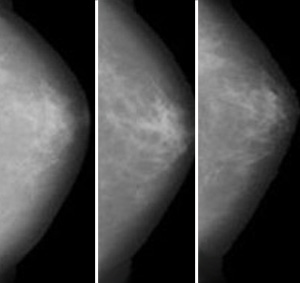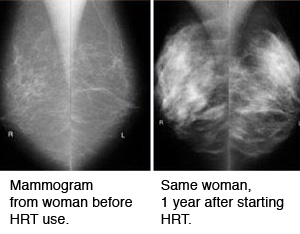Do Changes in Breast Density Over Time Influence Breast Cancer Risk?
Mammogram series
Mammogram series

Mammogram series
A series of mammograms taken from the same woman over the course of 10 years shows differences in the amount and proportion of dense tissue over time.
HRT use
HRT use

HRT use
These images show an example of a change that can occur in some women when they take hormones for postmenopausal symptoms. The mammogram on the left is from a woman before taking postmenopausal hormones. The mammogram on the right was taken from the same woman one year after she started hormones. This woman experienced a dramatic increase in breast density corresponding to her use of hormones. Whether this increase places a woman at an increased risk of breast cancer is unknown.
The Mayo Mammography Health Study research team is studying how women's breasts change in density over time, what underlies these changes and whether these changes are associated with the risk of developing breast cancer.
Breast density is not a static trait. Breast density changes with age, for example. On average, older women have lower density breast tissue than do younger women. The greatest change in density occurs during the menopause years. Breast density also changes with certain types of hormone therapies, such as hormone treatments for menopause.
Because a lower breast density is associated with a lower risk of breast cancer, it is hypothesized that decreasing density over time results in decreased cancer risk compared with women whose breast density increases or stays the same.
Dr. Vachon and her research team in the Mayo Mammography Health Study have published the first data to show that breast density on a mammogram correlates with involution in the breast.
Age-related lobular involution, or physiological atrophy of the breast, is a process in which there is a reduction in the number and size of the acini per lobule and replacement of the intralobular stroma with dense collagen and, ultimately, fatty tissue.
This process is important for understanding what breast density on the mammogram represents at the level of the tissue.
Related publications: